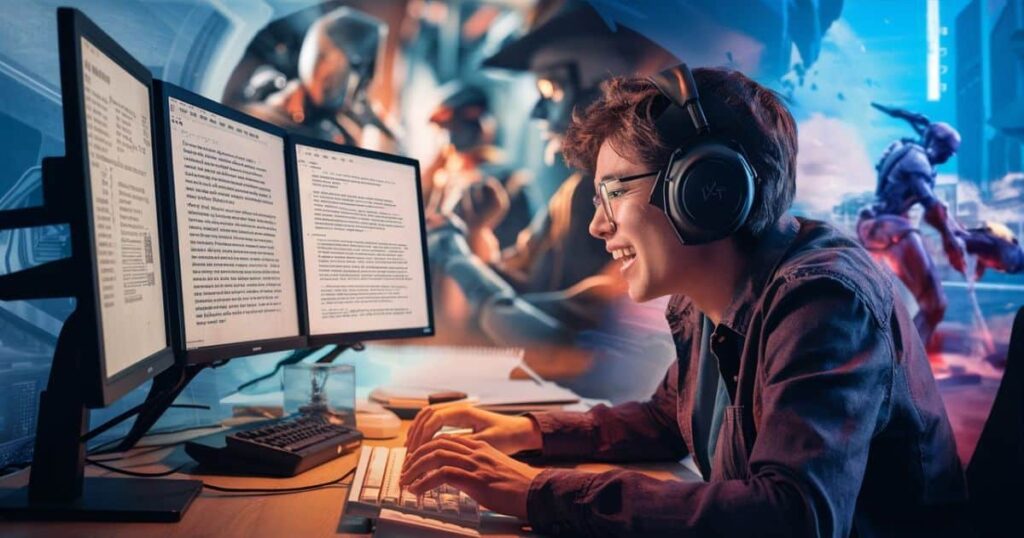The author sees gaming as more than just fun. They look at its history from simple beginnings to today’s global phenomenon. The author believes gaming offers benefits beyond entertainment. Like improving problem-solving skills and creating friendships.
But the author also addresses concerns about gaming. They talk about addiction and violence in games, but also mention efforts to make gaming more diverse and responsible. Personal stories from the author show how gaming can have a positive impact on people’s lives.
The author views gaming as a complex and evolving force. They want people to appreciate its potential for good while also being aware of its challenges. The essay encourages readers to think critically about gaming and its role in society.
Historical Context
To truly comprehend the author’s stance, we must first understand the historical backdrop of gaming. What began as a niche pursuit for a dedicated few has blossomed into a global phenomenon capturing the imaginations of millions worldwide. The author acknowledges gaming’s modest beginnings tracing its roots to the early days of digital entertainment, when rudimentary graphics and simple mechanics laid the foundation for an industry that would eventually captivate the masses.
As technology advanced gaming evolved in tandem, propelled by innovative developers and a burgeoning community of passionate players. The author recognizes this remarkable growth, attributing it to the relentless march of technological progress and the unwavering dedication of those who embraced gaming as more than just a pastime.
Positive Aspects of Gaming
One of the central threads woven throughout the essay is the author’s recognition of gaming’s numerous benefits. Beyond mere entertainment, the author highlights gaming’s potential to enhance cognitive abilities foster personal growth and cultivate valuable life skills.
For instance the author celebrates gaming’s capacity to bolster problem-solving skills, hand-eye coordination, and strategic thinking. Many games demand players to navigate intricate virtual worlds, devise creative solutions and execute precise movements, honing valuable cognitive and motor abilities in the process.
Moreover the author underscores the social connections forged within gaming communities. These virtual realms transcend geographical boundaries, bringing together individuals from diverse backgrounds, united by a shared passion for gaming. Collaborative gameplay fosters teamwork, communication and a sense of camaraderie that extends beyond the digital realm.
Negative Perceptions of Gaming
Here are some points about negative perceptions of gaming of author’s.
- Acknowledgment of Positive Aspects: The author recognizes the positive aspects of gaming, such as entertainment, skill development, and social interaction.
- Addressing Negative Stereotypes: The author confronts common criticisms of gaming, including addiction, sedentary lifestyles, and the portrayal of violence in certain games.
- Thoughtful Exploration: Criticisms are explored with thoughtful consideration, indicating a nuanced understanding of the complexities involved.
- Countering Notions: The author counters negative stereotypes by highlighting the gaming industry’s efforts towards self-regulation and the creation of diverse, inclusive gaming experiences.
- Emphasis on Responsibility: Emphasizes the importance of moderation and responsible consumption, suggesting that like any form of entertainment, gaming requires balance to reap its benefits while mitigating potential drawbacks.
Recommende Post: The Ultimate Guide to Understanding Tranny Tubes
Author’s Personal Experience with Gaming
To add a personal touch and lend credibility to their perspective, the author weaves in anecdotes from their own gaming journey. These relatable narratives not only humanize the discourse but also demonstrate the profound impact gaming can have on an individual’s life.
Whether it’s cherished memories forged through shared experiences or valuable life lessons learned in virtual worlds, the author’s personal anecdotes resonate with readers, inviting them to reflect on their own gaming adventures and the ways in which this medium has enriched their lives.
Gaming as Art
One of the essay’s most compelling arguments is the recognition of gaming as a legitimate artistic medium. The author celebrates the intricate world-building, storytelling, and audiovisual mastery that goes into crafting immersive gaming experiences.
From breathtaking digital landscapes to emotionally resonant narratives, the author urges readers to appreciate the creativity and craftsmanship behind these virtual realms. They draw parallels between gaming and traditional art forms, highlighting the artistic expression and creative vision required to bring these interactive worlds to life.
Examples of critically acclaimed games that have pushed the boundaries of storytelling and visual artistry are cited, further solidifying the author’s stance on gaming as a powerful artistic medium.
Gaming and Mental Health
The complex relationship between gaming and mental health is another aspect the author delves into with nuance and depth. While acknowledging the potential for excessive gaming to exacerbate certain conditions, they also shed light on the therapeutic benefits gaming can offer.
For some individuals, gaming provides a sense of accomplishment, a respite from daily stressors, and a means of social connection, all of which can have positive impacts on mental well-being. The author explores how games can offer a sense of control and mastery, boosting self-esteem and fostering a sense of purpose.
They also emphasize the importance of moderation and maintaining a healthy balance, recognizing that excessive gaming can indeed have detrimental effects on mental health if left unchecked.
Gaming and Society
The author’s perspective extends beyond the individual level, exploring gaming’s influence on society as a whole. On the positive side, they laud the industry’s economic impact, creating jobs and driving innovation across various sectors.
Additionally, the author highlights gaming’s ability to bring diverse communities together, transcending cultural and geographical boundaries. Gaming can serve as a common language, fostering connections and understanding among individuals from different walks of life.
They author also addresses concerns over representation, inclusivity, and the perpetuation of harmful stereotypes within certain gaming narratives. They underscore the need for the industry to embrace diversity and amplify underrepresented voices, ensuring that gaming remains an inclusive and welcoming space for all.
The Future of Gaming
Here are some points about future of gaming in the view of author’s.
- Future gaming trends push boundaries and redefine possibilities.
- Emerging technologies like virtual reality (VR) and artificial intelligence (AI) are speculated to revolutionize gaming.
- Potential developments include immersive virtual worlds and responsive AI-driven characters.
- Seamless integration of physical and digital environments is anticipated.
- Emphasis is placed on responsible game development and ethical practices.
- A sustainable and inclusive industry prioritizing player well-being and positive societal impact is advocated for.
Gaming and Education
One area where the author sees immense untapped potential is the integration of gaming into educational settings. They advocate for the incorporation of gamification techniques, where learning experiences are infused with game-like elements to enhance engagement and motivation.
The author highlights the value of educational games specifically designed to foster critical thinking, problem-solving skills, and subject-specific knowledge. By leveraging gaming’s inherent appeal and interactivity, educators can create immersive learning environments that captivate students and cultivate valuable skills.
Diversity and Inclusion in Gaming
Inclusivity is a recurring theme throughout the essay, reflecting the author’s belief that gaming should be a welcoming space for all. They commend the gaming industry’s efforts to create diverse narratives and characters, acknowledging the positive impact this can have on marginalized communities.
Representation matters, and the author underscores the importance of amplifying underrepresented voices and perspectives within gaming. By embracing diversity, the industry can foster a sense of belonging and validation for players from all backgrounds, enriching the gaming experience for everyone.
However the author also recognizes that there is still progress to be made in this realm. They call for continued efforts to promote inclusivity, challenge harmful stereotypes, and ensure that gaming remains a platform for celebrating and embracing diversity in all its forms.
Conclusion
To sum it up, their nuanced exploration, the author posits that gaming is a multifaceted phenomenon with far-reaching implications that extend beyond mere entertainment.
They encourage readers to approach gaming with an open mind, recognizing both its potential for personal growth and its ability to shape our collective cultural landscape.From fostering cognitive development and social connections to serving as a powerful artistic medium and a catalyst for positive societal change. And gaming is portrayed as a complex and evolving force that demands thoughtful consideration and appreciation.
Ultimately, the essay leaves readers with a newfound understanding of the depth and complexity of gaming, challenging preconceived notions and inviting a more nuanced discourse on this ever-evolving cultural phenomenon.







